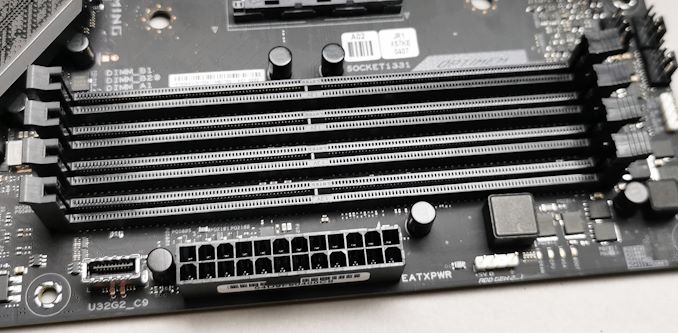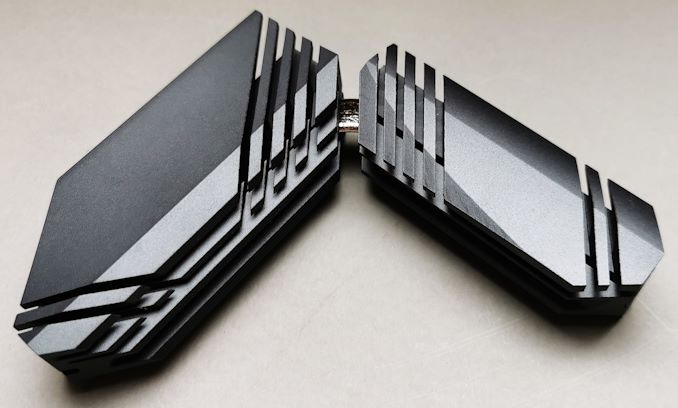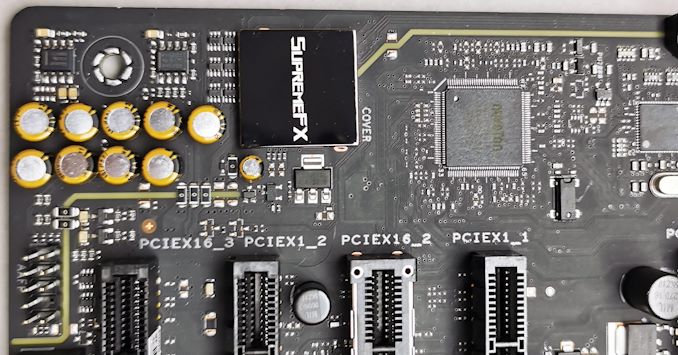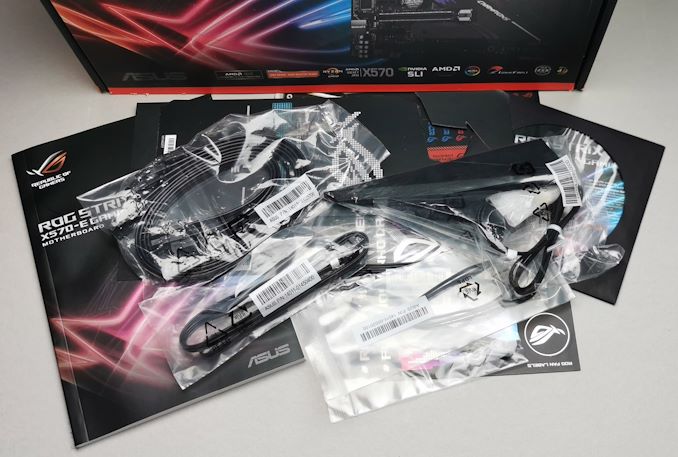The ASUS ROG Strix X570-E Gaming Motherboard Review
by Gavin Bonshor on January 25, 2021 11:00 AM EST- Posted in
- Motherboards
- AMD
- Asus
- ROG
- AM4
- Ryzen 3000
- X570
- Strix X570-E
- Ryzen 5000
- X570-E Gaming
Visual Inspection
ASUS has elected for an aggressive yet stylish design for its Strix series. It has a large rear panel cover with a large ROG logo that includes customizable illumination via integrated RGB LEDs. It also has a holographic Strix logo that also benefits from RGB LEDs too, with more RGB included within the chipset heatsink. The chipset heatsink includes a cooling fan, like the majority of X570 models, which is in no part due to increased temperatures from the pressures of PCIe 4.0. Across the board it uses a black PCB with subtle grey traces and glossy black text around the CPU socket area. ASUS is using gunmetal grey heatsinks for the power delivery and dual M.2 heatsinks, which blend in nicely against the black background.
Dominating the lower portion of the board is the chipset heatsink and M.2 heatsinks, but more importantly, the PCIe slots. The ASUS ROG Strix X570-E Gaming has three full-length PCIe 4.0 slots which operate at x16, x8/x8, and x8/x8/x+4, with two PCIe 4.0 x1 slots. Located above the top full-length and bottom full-length PCIe slots are two PCIe 4.0 x4 M.2 slots. Both slots can accommodate M.2 22110 form factor drives, and both include support for SATA drives. For other storage devices, ASUS uses the full allocation from the X570 chipset with eight SATA ports. All of these can support RAID 0, 1, and 10 arrays.
Other avenues of expansion include a single USB 3.2 G2 Type-C header which is located just below the 24-pin 12 V ATX power connector, while ASUS also includes one USB 3.2 G1 Type-A header for two additional ports and two USB 2.0 headers which allow for another four ports. Adding the USB up including the rear panel, ASUS allows for a total of 13 x Type-A and 2 x Type-C. Along the bottom is a two-digit LED Debugger, while located around the edge of the PCB are seven 4-pin headers for cooling.
In the top right-hand corner, there are four memory slots. These allow users to install up to 128 GB of memory, with maximum speeds of up to DDR4-4400.
The ASUS ROG Strix X570-E Gaming is using a 16-phase power delivery, which is split into twelve for the CPU and four for the SoC. Keeping the VRMs regulated is an ASUS specific ASP1405 PWM controller operating at 6+2. For the CPU VCore, it is using twelve International Rectifier IR3555 60 A power stages, while SoC is using four IR3555. Both the CPU and SoC are Teamed together, which allows the power delivery to run cooler and it improves transient response with quicker bursts of power without the drawbacks of phase doublers. Feeding power to the CPU is an 8-pin and 4-pin pair of EPS 12 V power inputs.
Keeping the power delivery cool is a gunmetal grey pair of heatsinks that are interconnected with a single heat pipe. This heatsink pairing is quite bulky and heavy and has some thicker thins designed to channel airflow over the power delivery.
Looking at the board's audio capabilities, it all flows around a SupremeFX S1220A HD audio codec, with dual OP amplifiers designed to boost the overall auditory output. The S1220A codec includes a SupremeFX EMI shield and uses nine Japanese Nichicon gold audio capacitors. Keeping the audio components separate from the rest is a PCB isolation line.
The rear panel on the ASUS ROG Strix X570-E Gaming has a phenomenal amount of USB connectivity. This includes seven USB 3.2 G2 Type-A and a single USB 3.2 G2 Type-C port. Networking capability is also solid with two RJ45 ports, one powered by a Realtek RTL8125-CG 2.5 GbE controller and the other by an Intel I211-AT Gigabit controller. For wireless connectivity, ASUS includes an Intel AX200 Wi-Fi 6 module which also provides support for BT 5.0 devices. The rear panel also has five 3.5 mm color-coded audio jacks and S/PDIF optical output powered by the SupremeFX S1220A HD audio codec, while a BIOS Flashback button and a designated Type-A port. Finishing off the rear panel is a DisplayPort 1.2 and HDMI 2.0b video output pairing.
What's in The Box
Accompanying the ASUS ROG Strix X570-E within the packaging is a variety of accessories. The most notable of these include four SATA cables, an Intel AX200 Wi-Fi 6 antenna, two RGB extension cables, a Strix branded door hanger, and a small ROG Strix sticker sheet.
- 4 x SATA cables
- M.2 screw kit
- Driver/Software installation DVD
- User manual
- Strix Door Hanger
- ROG Thank you card
- ROG Strix sticker sheet
- Intel AX200 Wi-Fi 6 antenna
- RGB extension cable (80 cm)
- ARGB extension cable (80 cm)
- Thermistor cable
- Cable Tie pack

















46 Comments
View All Comments
pradeepsekar - Tuesday, January 26, 2021 - link
Correct.Just sharing my experience -
I got a 5950X and Corsair 3600 C18 RAM from the QVL. Loaded up the latest BIOS 2802 and them boom - error and the board would not boot. Had to take it to the ASUS service center, and wait for over an hour. The engineer assigned was super helpful though. He had me wait for some time, and tested the board with a lower processor. He downgraded the BIOS to the next lower stable version, and it worked well when I got it home. Now I am on 3001 and everything continues to work fine. It occasionally greets me with multiple beeps, but ends up booting into Windows anyways... Need to investigate that more but it is not replicable... Anyways, I will stay away from the beta BIOS versions :-)
I agree about the placement of the chipset and the graphics card - they are right next to each other. I am on a NVIDIA Founders edition card. It blows all the warm air out of the chassis and not into it. So for the moment I have not seen high temperatures (yet). The chipset fan looks like a tiny fragile thing one would see on a laptop - with a lot of potential to make a noise when it gets running at a high speed...
Coming from a much older version the menus took some getting used to. All options are present and laid out neatly, as I realized later - with several options that I do not understand fully, and hence do not intend touching till I know better! Just got the RAM running with the XMP (DOCP) profile. I do not intend to overclock the processor - a crazy thought perhaps, but my rig is already screaming fast at everything I throw at it...
Spunjji - Tuesday, January 26, 2021 - link
Beaver M. could learn a lot about what a persuasive, measured post looks like from this one. Cheers for sharing your experience.Knightworld - Wednesday, January 27, 2021 - link
Try running 3200 MHz for the RAM XMP profile. That's what the highest the CPU can handle while being stable without OC. That's the recommended by AMDKnightworld - Wednesday, January 27, 2021 - link
Well of coarse there will be BIOS updates. This is quite an old board in terms of computer standards. Lots of chipset optimisations to accommodate Zen 3 ryzen.Knightworld - Wednesday, January 27, 2021 - link
Also the chipset placement is pretty standard in all boards. Be it ASUS and MSI or Gigabyte or any other MoBo manufacturer. The chipset doesn't ramp up in boost or anything so it usually remains at a constant temp. And using the second slot for main GPU cause more strain on the chipset, since the second slot connects to the chipset and not the CPU. Also with the new GPU from Nvidia, the 3000 series your chipset shouldn't have any issues with the cooling since the special GPU coolers help with that. Tho that is only if you upgrade the GPU.Oxford Guy - Monday, January 25, 2021 - link
'Both the CPU and SoC are Teamed together, which allows the power delivery to run cooler and it improves transient response with quicker bursts of power without the drawbacks of phase doublers.'What drawbacks?
Oxford Guy - Monday, January 25, 2021 - link
'This is also typically run at JEDEC subtimings where possible. It is noted that some users are not keen on this policy, stating that sometimes the maximum supported frequency is quite low, or faster memory is available at a similar price, or that the JEDEC speeds can be prohibitive for performance. While these comments make sense, ultimately very few users apply memory profiles (either XMP or other) as they require interaction with the BIOS. Most users will fall back on JEDEC supported speeds'1. Reviews expensive enthusiast board, where we literally are told about what specific VRM components are present.
2. Makes claims above.
3. Facepalm.
nils_ - Monday, January 25, 2021 - link
I saw this in another benchmark article as well. Know your audience Anandtech, of course we care about this. Most people don't build their own computers, so why even benchmark individual components?Spunjji - Tuesday, January 26, 2021 - link
I'd go as far as to say this is the first instance where I've seen this particular criticism being levelled and haven't been inclined to immediately dismiss it. That text doesn't really belong in this article.Oxford Guy - Monday, January 25, 2021 - link
1. Most users aren't going to use POV-Ray so don't include it in the article.2. Most users aren't going to worry about what VRM components are on the board so don't include it in the article.
3. Most users aren't going to use a RAID array so don't include information about RAID in the article.
4. Most users aren't going to use ethernet that's any faster than gigabit so don't including info about that in the article.
How long should this post be? It's the exact non-credible argument used to test at JEDEC. Now that AMD is rating, officially, for 3200 (which means even the lowest-quality AM4 board will support it), the problem isn't as severe as it was but it's still stupid since everyone has known that 3600 was the sweet spot for the previous round of Zen, not 3200.